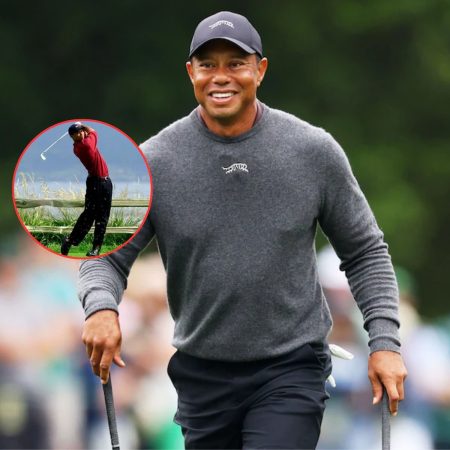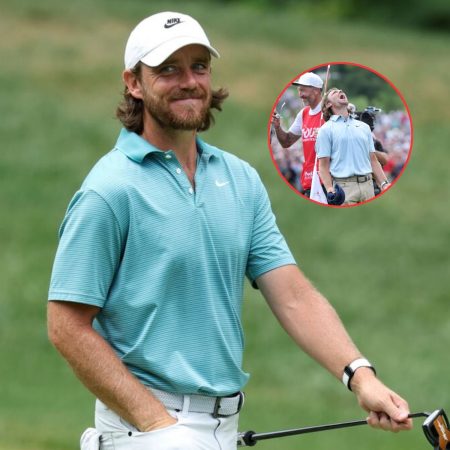You want to know what pure, unfiltered greatness looks like? Let me take you back to Kapalua—January 2000—the Tournament of Champions, now known as The Sentry. It’s the kind of showdown that doesn’t just make golf fans. It makes legends. Picture this: two giants in their prime, trading haymakers with every swing. One, a dominant force riding a historic win streak. The other, a global phenom desperate to prove he belonged on that same mountain. The air was heavy with tension, the ocean winds whipping across the fairways, and every shot carried the weight of legacy. What happened next? Well… let’s just say it’s the kind of finish that still keeps one of them up at night, twenty-five years later.

Both Tiger Woods and Ernie Els were at the peak of their powers—or at least Woods had reached such heights, he looked invincible. Els? He wasn’t just any other challenger. He was the guy who could go toe-to-toe with Woods, shot for shot, and on that sun-soaked week in Hawaii, he nearly did it. Nearly. But the way it all went down was storybook stuff, if the book was written by Tiger Woods and heartbreak was spelled E-L-S. That’s how Ernie Els opens his recollection of the duel in a brand-new PGA TOUR Originals interview on Woods’ legendary 2000 season. “Oh my gosh, Kapalua, man… um, that one still stings a little bit.” He says it with a little chuckle, but the truth is written all over his face. The Big Easy hasn’t forgotten, and probably never will.
Woods even laughs about it now. “Yeah, it took a long time,” he said when asked if Els ever gave him a hard time about that one. “He laid into me a little bit, which was awesome. I loved it, and we had a good time about it.” Though their rivalry was fierce, Tiger Woods and Ernie Els grew to share a deep mutual respect. What began as heated competition—like their unforgettable playoff at Kapalua—evolved into camaraderie built on shared battles and admiration. Els often praised Woods as a once-in-a-generation force, and over time, their connection became less about rivalry and more about legacy.
At Kapalua, Woods was going for five wins in a row. But standing in the way was Ernie Els: World No. 5 at the time, while Woods was No. 1, but Els had been surging with confidence. “I wanted to get into that group of players where I felt I belonged,” he said then. “And that was going to take a little bit more hard work.” He backed it up with one of the best ball-striking performances of his life. For three days, Els matched Woods—step for step, swing for swing. “Been playing together for three days up to that point — I knew coming down the stretch, somebody had to do something.” Woods took the lead with a birdie on 15. But Els wasn’t backing down. On 18, both players dropped phenomenal shots into the green—Woods first, then Els one-upping him. The gallery went nuts. Two birdies. Off to a playoff.
First playoff hole? Both birdies. High drama. Second playoff hole? Enter Woods, and the putt. Els remembered that moment vividly in the new interview: “The wind was really howling, and the flag was in front. We couldn’t quite get the ball very close to the hole on our second shots. He had like a 40-footer, and I just had this Yeti feeling.” He wasn’t wrong to worry. “He just had it within himself to be aggressive at the right time,” Els added. “You had to be aggressive with that putt.” Tiger Woods sized it up, saw the line, and just… drilled it. A 40-foot dagger. Pure Woods. Pure cold-blooded execution.
Throwback to 2000. 🐅#TheSentry | @TigerWoods pic.twitter.com/pIRwyRM9GX
— The Sentry (@TheSentry) December 1, 2023
Then came Ernie’s shot—his last hope. “I saw the line, and I didn’t quite hit it hard enough.” The ball came up short. Game over. “New season, same result—another Tiger Woods win,” announced the commentator. That was the call. And it was the truth. Woods won his fifth straight start. The season would go on to be his most dominant ever—nine wins, three majors, untouchable form. But for Els? Kapalua, of course, was the one that got away. “I was involved with that 2000 season quite a bit, man. I played good golf,” he says now, reflecting on what that loss meant. And he’s right. He did play good golf. Elite golf, even. By the end of 2000, Tiger Woods and Ernie Els were two titans on very different trajectories. Woods, at just 24, had already racked up 24 PGA Tour wins, including five majors, and was coming off the most dominant season in golf history. Els, seven years older, had 38 professional victories worldwide, including two U.S. Opens, and was widely regarded as the best international challenger to Tiger’s reign. Both were elite—but when you’re up against Tiger Woods in full flight, sometimes even your best isn’t enough.
That’s the sting. That’s what Ernie Els still feels, even now. Twenty-five years on, the Sentry showdown at Kapalua remains one of the most iconic opening acts in PGA TOUR history. The gravity of this situation wasn’t just felt by the players—it echoed through the sport.
How the golf world reacted to Woods vs. Els at Kapalua
In the days following Tiger Woods’ legendary playoff win over Ernie Els at the 2000 Sentry Tournament of Champions, the golf world didn’t just buzz—it roared. Ernie Els himself, just 30 years old at the time and already a two-time major winner, couldn’t help but tip his cap to Woods’s brilliance. “He’s a legend in the making, if not already,” Els said. “He’s 24. He’s probably going to be bigger than Elvis when he gets into his 40s.” That wasn’t just frustration talking—it was respect from a man who’d gone toe-to-toe with golf’s most dominant force and watched him pull off the impossible under playoff pressure.
Woods came into the new millennium already chasing the shadows of history. Jack Nicklaus had just been dubbed Golfer of the 20th Century, and people were already pointing at Woods as the heir to that title. Asked back then if he saw himself as the golfer of the next century, Woods, ever focused, replied: “That’s a strong question to ask already, but I’m going to do one thing—I’m going to continue to work hard and be patient with it.” And then, almost casually: “Hopefully, I can either come close to [Nicklaus’s] accomplishments. And if I get lucky, maybe exceed them.” Spoiler alert: he did.
Curtis Strange, two-time U.S. Open champ turned ABC analyst, saw the moment as more than just a duel—it was a call to arms for the rest of the Tour. “He [Els] has always been the guy that I thought had the ability to get better and contend for No. 1… If there’s ever a time, it might be now because of his start.” Even longtime broadcaster Mark Rolfing, stationed greenside for the broadcast, had a front-row seat to history. He caught Woods muttering to caddie Steve Williams, “I can make it,” before draining the 40-foot dagger in the second playoff hole. “I knew right then after he made it,” Rolfing later said, “that was the difference between those two guys.” And Rocco Mediate, never one to hold back, perfectly captured the sentiment of the chasing pack: “I don’t see a problem with Ernie challenging Tiger for the next however many years… I certainly think Tiger would love for that to happen. He likes to be pushed.”
This wasn’t just another win for Tiger—it was a seismic moment. A tone-setter for the 2000 season. And for everyone watching, especially the players inside the ropes, it was a wake-up call: Tiger wasn’t just great. He was inevitable.





